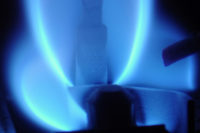
These days, the Sunshine State seems to be growing more students than oranges. Thanks to an abundance of young Floridians and others seeking an education in warmer surroundings, Florida's school-age population rose 39% between 1986-1996. Furthermore, the state's K-12 enrollment is expected to grow another 45% between 1996 and 2000.
That student boom means demands for Florida's universities to extend their classroom hours, increasing utility costs and accelerating the aging of mechanical equipment. New research centers and other high-tech buildings help keep pace with educational progress, but they are requiring vast amounts of energy nevertheless. And with funding for higher education (as a percentage of the state's total revenue) declining amid these changes, it's not an easy time to manage a school's energy resources.
Four universities have enlisted a corporate ally to try to maintain first-rate facilities without running the budget into the red.
Have It Made In Dade?
Florida International University (FIU) can see the waves of students coming its way. The surrounding two school districts (Dade and Broward counties) have added 200,000 students within the last decade alone. In response, FIU has added five buildings in recent years, and the typical school day now runs from 6 a.m. to midnight."We're running our buildings harder than we ever anticipated," says Nicholas DiCiacco, executive director of business and finance for FIU's North Campus. DiCiacco feels the heat in more way than one, knowing that air conditioning performance is exceptionally important in his location.
Through a Request for Proposal, FIU selected Johnson Controls (Milwaukee) to conduct costly but essential improvements and secure third-party financing. Phase One brought numerous improvements, including lighting retrofits and air conditioning system replacements. Phase Two involved upgrading the North Campus chiller plant. As a result, $6.1 million in energy and operational savings over a 10-yr period are expected; that would pay for all the expenses, with the college receiving any extra savings beyond the term of the performance contract.
DiCiacco notes that things are running "smoother than ever" since the renovation, and thus he's receiving fewer temperature complaints.
"This has freed our people to devote more time to preventive maintenance programs, which gives us better control over our operations budget," he says. In fact, the success of FIU's project caught the eye of Alan Peck, Florida State University's associate director for facilities operation and maintenance. His school was going through the very same Request for Proposal selection process, and he made the trip from Tallahassee to FIU to get advice and a firsthand look. Peck wound up taking FIU's recommendation, and the school embarked on a similar slate of substantial lighting upgrades, installation of variable-speed drives and heat recovery devices on air handlers, and other conservation measures. A number of the campus' buildings date from the 1950s and 1960s and have original hvac systems that are long overdue for replacement, so Peck's work is far from done. But his school's initial project, and its $8.5 million estimated savings, represent a start and should help pay for those eventual retrofits.
Gators Bite Into Costs
On the other hand, a commitment to long-term planning and foresight has rescued Gainesville's University of Florida from unwelcome quick-fix scenarios. The school has developed a very detailed set of construction standards that specify a handful of suppliers who have an established relationship with the school, providing everything from light bulbs to chillers.One example of this proactive, long-term approach is the school's cogeneration plant, added in 1995. It now saves the college over $1 million each year in electricity costs. The mid-1990s also brought a central chilled-water loop, relying on controls from Johnson, to increase operational efficiency and protect the school from a major chiller failure.
"Our infrastructure is in fairly good shape because the leadership has recognized the importance of facility improvements for some time," says David O'Brien, physical plant director.
However, enrollment increased from 35,000 in 1989 to 42,000 in 1997, with plans to reach 45,000 soon. To combat this latest challenge, the college's ESPC covers lighting and mechanical retrofits in 34 buildings (about 20% of the campus' total square footage). A savings of $4 million annually is expected, with more phases of the project to come.
A Different School Of Thought
On the heels of the University of Florida, there is Florida Gulf Coast University, the state's newest university. The school has already earned a reputation for doing things differently. Professors are signed to long-term contracts, because tenure is not offered. There is no central administration building, and the president's office is found in the library. Through strategies such as these, the university believes it can educate students while using 25% less space than a typical university. And as hvac designers know, space is money.In keeping with this philosophy, the school has chosen the Metasys facility management system to support the facilities it does have. Thus, it is enjoying from the start a variety of benefits other schools enjoy only after retrofits. The system monitors the chiller plant, and integration may extend its application to fire, security, elevators, and power management.
"Eventually, we want the ability to manage our total facilities from a single computer screen," says C.R. Lyons, the university's physical plant director. "This would enhance productivity because we wouldn't have to train people in different software program interfaces."
Young or old, universities across Florida cannot afford to ignore the inevitable onslaught of crowded halls and classrooms as enrollments leap upward; fortunately, they are all finding ways to stretch their resources and brace for the bell to ring.ES

